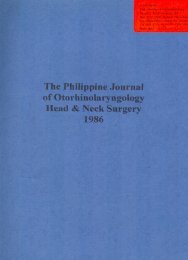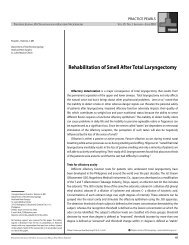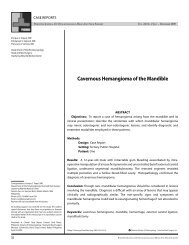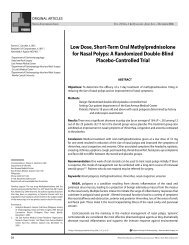You also want an ePaper? Increase the reach of your titles
YUMPU automatically turns print PDFs into web optimized ePapers that Google loves.
Appearance Presence of Duration Recurrent thologically recognized entity that is characterized<br />
NatureLymph<br />
Nodes by cutaneous nodules, single or multiple, 1-10 cms<br />
in diameter often located in the cheek and auricular<br />
Keloid + + + region. It is also characterized by cutaneous<br />
Malignancy + + + proliferating blood vessels with a typical histiocytelike<br />
endothelial cells and numerous eosinophils.<br />
Besides, previous histopath does not favor keloid A peripheral eosinophilia may be present but there<br />
because there was no collagen formation and neither are no known systemic manifestations. 85% occur<br />
cancer because there were no malignant changes in males. Pain and tenderness are rare although<br />
noted. Consensus then was to do an incisional biopsy pruritus may sometimes occur. It is rather rare disease<br />
of the earlobe mass. Biopsy was done and histopath with only about 250 cases reported in world literature.<br />
result revealed stratified squamous epithelium with<br />
hyperkeratosis and acanthosis. The dermis con- Histologically the lesions are characterized by<br />
tained lymphoid follicles with prominent germinal 3 striking features that are always present. The<br />
centers and sheets of proliferating capillary endothe- vascular element, which preponderates in early more<br />
lium scattered within the loose connective tissue active cases and the lymphoid or cellular element,<br />
stroma with numerous eosinophils. There is no which predominates in the later quiscent stages.<br />
evidence of malignancy. The final report read- Other important diagnostic features include diffuse<br />
Angiolyphoid Hyperplasia with Eosinophilia, the same mast cell and eosinophil infiltrations of the dermis<br />
result in the previous excision, and subcutaneous tissues as well as serum eosinophilia.<br />
Usually, copious numbers of eosinophils and<br />
What seemed to be a descriptive term and which lesser numbers of plasma cells, lymphocytes, and<br />
was not given much attention is the past, now became histiocytes are present in close association with<br />
a topic of curiosity, capillary neogenesis. Sometimes lymphoid nodules<br />
may be present. (Thompson, 1981).<br />
Post biopsy, patient had a 2.5 x 2.0 cm. mass<br />
on his left earlobe with two palpable cervical lymph According to Goldman, the cause and phtonodes.<br />
Management of this kind of disease can be genesis of this process remian unknown. Recent<br />
surgical. But now we opted to be conservative. He studies have showr/that the type of progenitor cell<br />
was started on steroids at a dose of 30 mg bid and of the lesion is probably a transitional histiocyticafter<br />
one week, mass had regressed to about One cm. endothelial cell and that the proliferation of these<br />
in size and consistency changed from hard to soft. elements may represent a response of this basic<br />
Cervical lymph nodes were no longer palpable, vascular cell to an inflammatory or injuries stimulus.<br />
One year later, no mass was noted and the It was in 1.948 when Kimura et al first described<br />
patient is now back to normal. After nine years an unusual s_cin disease with "unusual granulation<br />
of carrying theburdenofhavingamassinhis earlobe, combined with hyperplastic changes of lymphatic<br />
patient finally found relief not through surgical means tissue." Kawada in 1966 reported four cases. Well<br />
but through systematic steroids, and Whimster in 1969 had nine cases. In 1971<br />
Mehregan and Shapiro in a study of 14 patients<br />
DISCUSSION stated that vascular proliferation associated with the<br />
formation of lymphoid follicles and tissue eosino-<br />
The histopathologic diagnosis points to a rather philia is also characteristic of a disease entity<br />
uncommon, rarely heard of disease called Angiolym- described in Japanese literature asKimura's Disease.<br />
phoid Hyperplasia with Eosinophilia. It seems to It has since then been known under the title<br />
be a mere description of the microscopic findings of Angiolymphoid Hyperplasia with Eosinophilia and<br />
but it is actually a disease entity in itself. What later on Kimura's Disease. It has several other names<br />
then is Angiolymphoid Hyperplasia with Eosino- such as angioblastic lymphoid hyperplasia with<br />
philia eosinophilia, eosinophilic lymph-folliculosis of<br />
skin, papular angioplasia, and inflammatory angio-<br />
Angiolymphoid Hyperplasia with Eosinophilia matous nodules. But is ALHE really similar to<br />
or abbreviated (ALHE) is a clinically and histopa- Kimura's disease Wells and Whimster in 1965<br />
35
















